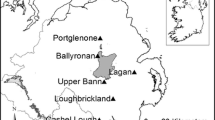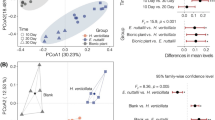Abstract
Wetlands are subject to invasion by exotic plant species, especially during the dry season when they resemble terrestrial systems; therefore, terrestrial plants could exploit this situation to colonize this environment. We analyzed P. anserina invading Patagonian wetlands in terms of elemental ratios that would modify wetland stoichiometry due to organic matter inputs. We studied the elemental relationship (carbon/nitrogen/phosphorus) of P. anserina in comparison with native emergent macrophytes (Eleocharis pachicarpa and Carex aematorrhyncha). These plant species are common and dominant in the wetland. Additionally, we analyzed the presence of mycorrhizal fungi in the roots and their proportion of root infection. Our study reveals that the invasive species presented nutrient (especially phosphorus) allocation in roots and differences in mycorrhizal infection, with a predominance of arbuscular mycorrhiza, compared with native species. During flooded periods with the decay of aerial parts, P. anserina stores phosphorus in the roots and releases dissolved organic matter of high molecular weight molecules, high color, and a high C-to-nutrient ratio in comparison with native macrophytes. These results show the strategy of an invasive terrestrial plant in temporary aquatic systems, and how the elemental relationships of the invasive plant can modify the stoichiometry of the environment.







Similar content being viewed by others
References
Aerts R, Chapin FSI (2000) The mineral nutrition of wild plants revisited: a re-evaluation of processes and patterns. Adv Ecol Res 30:1–67
Anesio MA, Denward CMT, Tranvik LJ, Graneli W (1999) Decrease bacterial growth on vascular plant detritus due to photochemical modification. Aquat Microb Ecol 17:159–165
Anesio AM, Theil-Nielsen J, Graneli W (2000) Bacterial growth on photochemically transformed leachates from aquatic and terrestrial primary producers. Microb Ecol 40:200–208
APHA (2005) Standard methods for the examination of water and wastewater. American Public Health Association, AWWA, Washington
Bastidas Navarro M, Modenutti BE (2010) UVR induce optical changes and phosphorous release of lake water and macrophyte leachates in shallow Andean lakes. J Limnol 69:112–119
Bastidas Navarro M, Balseiro E, Modenutti B (2009a) Effect of UVR on lake water and macrophyte leachates in shallow andean-patagonian lakes: bacterial response to changes in optical features. Photochem Photobiol 85:332–340
Bastidas Navarro M, Modenutti B, Callieri C, Bertoni R, Balseiro E (2009b) Balance between primary and bacterial production in North Patagonian shallow lakes. Aquat Ecol 43:867–878
Bertilsson S, Jones JB (2003) Supply of dissolved organic matter to aquatic ecosystem: autochthonous sources. In: Findlay SEG, Sinsabaugh RL (eds) Aquatic ecosystems: interactivity of dissolved organic matter. Academic Press, San Diego, pp 3–24
Brundrett M, Melville L, Peterson L (1994) Isolating and propagating Glomalean fungi. In: Brundrett M, Melville L, Peterson L (eds) Practical methods in mycorrizal research. Mycologue Publications, Waterloo
Caceres CE, Tessier AJ, Andreou A, Duffy MA (2008) Stoichiometric relationships in vernal pond plankton communities. Freshw Biol 53:1291–1302
Cardoso BM, Chaia EE, Raffaele E (2010) Are Northwestern Patagonian “mallín” wetland meadows reservoirs of Ochetophila trinervis infective Frankia? Symbiosis 52:11–19
Champion PD, Reeves P, Zealand N (2009) Factors causing dune ephemeral wetlands to be vulnerable to weed invasion. Publishing Team, Department of Conservation
Cornwell WK, Bedford BL, Chapin CT (2001) Occurrence of arbuscular mycorrhizal fungi in a phosphorus-poor wetland and mycorrhizal response to phosphorus fertilization. Am J Bot 88:1824–1829
Correa MN (ed) (1984) Escalloniaceae, Dicoliledoneae dialipétalas (Rosaceae a Leguminosae). Flora Patagónica. Colección Científica, INTA, Buenos Aires, pp 77–73
Davis SM (1991) Growth, decomposition, and nutrient retention of Cladium jamaicense Crantz and Typha domingensis Pers. in the Florida Everglades. Aquat Bot 40:203–224
Del Giorgio PA, Cole JJ (1998) Bacterial growth efficiency in natural aquatic systems. Annu Rev Ecol Syst 29:503–541
Demars BOL, Edwards AC (2007) Tissue nutrient concentrations in freshwater aquatic macrophytes: high inter-taxon differences and low phenotypic response to nutrient supply. Freshw Biol 52:2073–2086
Díaz Villanueva V, Trochine C (2005) The role of microorganisms in the diet of Verger cf. limnophilus (Trichoptera: Limnephilidae) larvae in a Patagonian Andean temporary pond. Wetlands 25:473–479
Dunham RM, Ray AM, Inouye RS (2003) Growth, physiology, and chemistry of mycorrhizal and nonmycorrhizalTypha latifolia seedlings. Wetlands 23:890–896
Ezcurra C, Brion C (2005) Plantas del Nahuel huapi. Universidad Nacional del Comahue and Red Latinoamericana de Botánica, San Carlos de Bariloche
González AL, Kominoski JS, Danger M, Ishida S, Iwai N, Rubach A (2010) Can ecological stoichiometry help explain patterns of biological invasions? Oikos 119:779–790
Hauenstein E, Paña-Cortés F, Bertrán C, Tapia J, Schlatter R (2008) Floristic comparison and trophic condition based on indicator species in coastal lagoons of the Araucanian region, Chile. Ecología Austral 18:43–53
Jumpponen A (2001) Dark septate endophytes—are they mycorrhizal? Mycorrhiza 11:207–211
Modenutti BE, Balseiro E, Dieguez MC, Queimaliños C, Albariño R (1998) Heterogeneity of fresh-water Patagonian ecosystems. Ecologia Austral 8:155–165
Morris DP, Zagarese H, Williamson CE et al (1995) The attenuation of solar UV radiation in lakes and the role of dissolved organic carbon. Limnol Oceanogr 40:1381–1391
Naiman RJ, Melillo JM (1984) Nitrogen budget of a subarctic stream altered by beaver (Castor canadensis). Oecologia 62:150–155
Osborne TZ, Inglett PW, Reddy KR (2007) The use of senescent plant biomass to investigate relationships between potential particulate and dissolved organic matter in a wetland ecosystem. Aquat Bot 86:53–61
Pace ML, Cole JJ (2002) Synchronous variation of dissolved organic carbon and color in lakes. Limnol Oceanogr 47:333–342
Perez MT, Sommaruga R (2006) Differential effect of algal- and soil-derived dissolved organic matter on alpine lake bacterial community composition and activity. Limnol Oceanogr 51:2527–2537
Prieur-Richard AH, Lavorel S (2000) Invasions: the perspective of diverse plant communities. Austral Ecology 25:1–7
Raffaele E (1996) Relationship between seed and spore banks and vegetation of a mountain flood meadow (Mallín) in Patagonia, Argentina. Wetlands 16:1–9
Raffaele E (2004) Susceptibility of a Patagonian mallín flooded meadow to invasion by exotic species. Biol Invasions 6:473–481
Richardson DM, Pyšek P, Rejmánek M, Barbour MG, Dane Panetta F, West CJ (2000) Naturalization and invasion of alien plants: concepts and definitions. Divers Distrib 6:93–107
Roehm CL (2005) Respiration in wetland ecosystems. In: del Giorgio P, Wuliams P (eds) Respiration in aquatic ecosystems. Oxford University Press, Montreal, pp 83–102
Souza MS, Balseiro E, Laspoumaderes C, Modenutti B (2010) Effect of ultraviolet radiation on acetylcholinesterase activity in freshwater copepods. Photochem Photobiol 86:367–373
Sterner RW, Elser JJ (2002) Ecological stoichiometry. The biology of elements from molecules to the biosphere. Princeton University Press, Princeton
Valderrama JC (1981) The simultaneous analysis of total nitrogen and total phosphorus in natural waters. Mar Chem 10:109–122
Van TK, Wheeler GS, Center TD (1999) Competition between Hydrilla verticillata and Vallisneria americana as influenced by soil fertility. Aquat Bot 62:225–233
Ventura M, Liboriussen L, Lauridsen T, SØNdergaard M, Jeppesen E (2008) Effects of increased temperature and nutrient enrichment on the stoichiometry of primary producers and consumers in temperate shallow lakes. Freshw Biol 53:1434–1452
Wong PK, Liang Y, Liu NY, Qiu JW (2010) Palatability of macrophytes to the invasive freshwater snail Pomacea canaliculata: differential effects of multiple plant traits. Freshw Biol 55:2023–2031
Zedler JB, Kercher S (2004) Causes and consequences of invasive plants in wetlands: opportunities, opportunists, and outcomes. Crit Rev Plant Sci 23:431–452
Zedler JB, Kercher S (2005) Wetland resources: status, trends, ecosystem services, and restorability. Ann Rev Environ Res 30:39–74
Acknowledgments
This work was supported by FONCyT PICT 2007-01256 and FONCyT PICT 2007-01258 and UNComahue B-141. FC is a CONICET fellowship and EB and BM are CONICET researchers. We also thank Marcela Bastidas Navarro, Marta Cabello and Nora Baccalá for their help in laboratory analysis, mycorrhizal identification and statistical analysis respectively.
Author information
Authors and Affiliations
Corresponding author
Rights and permissions
About this article
Cite this article
Cuassolo, F., Balseiro, E. & Modenutti, B. Alien vs. native plants in a Patagonian wetland: elemental ratios and ecosystem stoichiometric impacts. Biol Invasions 14, 179–189 (2012). https://doi.org/10.1007/s10530-011-9995-9
Received:
Accepted:
Published:
Issue Date:
DOI: https://doi.org/10.1007/s10530-011-9995-9




